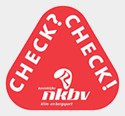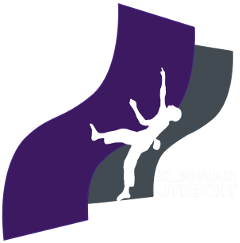“Getting to the summit is optional, getting down is mandatory.” – Ed Viesturs (only American to have climbed all eight-thousanders)
Climbing and mountaineering are not risk-free. As USAC, we cannot deny that. However, with proper preparation, partner checks, and training, the risks of the sport can be reduced to an acceptable minimum. This page provides an overview of common hazards and risks and how we deal with them as a club. The focus is on outdoor climbing, and alpine climbing, but of course pay attention to safety indoors as well: do the partner check and keep your focus when securing (especially when preclimbing-sailing). Don’t do things you are not authorized to do, and listen to staff and kader.
Of course, reading this page once is not enough to prevent all accidents. Much more importantly, we need to discuss risks, dangers, and accidents together. We think it is important to know how safety is perceived within the association. If you have experienced a (potentially) dangerous situation, we would like to hear about it so that we can respond to it in the future. Let us know via bestuur@usac.alpenclub.nl and oc@usac.alpenclub.nl.
Should you be involved in an accident, it is important to report it on klimongevallen.nl. Here Dutch mountaineers, sport climbers and mountain hikers can register accidents or near misses. The purpose of this site is to get a better understanding of what goes wrong when practicing mountaineering, and to learn from the mistakes of others.
If you see something happening that you think is not safe, speak up to others about it. Are you confronted about something yourself? Keep it open for discussion and do not immediately go on the defensive. Dare to look at yourself critically. Sometimes there are multiple solutions to a case: try to be open to the pros and cons of the techniques you use and do not take advice or criticism as a personal attack.
Responsibility
Educating about safe climbing and mountaineering and providing training and courses is a core mission of the USAC. In training courses, you are educated about risks and learn where your limits are depending on how far along you are in the sport. This applies to both sport climbing and alpine courses.
Knowledge of the sport must be kept up to date. Just because you passed a course in the distant past does not mean you still know everything by heart. Practice and repeat things you learned. Have you forgotten a technique? Don’t hesitate to check with an kader member or experienced alpinist.
There is not always a kader member, or a guide, to prevent you from exceeding the limits of your ability – think about the alpine camping, for example. Of course we can learn from each other in association, but keep an eye on your own level and that of others, and don’t do things you are not ready for. Many accidents happen because of self-overestimation, fatigue or lack of focus. A climber or mountain sportsman who practices his or her sport responsibly possesses a good dose of (self) knowledge, dares to turn around if something is too dangerous, and is open to recommendations to make the sport safer. The headings “Safety in the Alps” and “Safe Sports Climbing” describe in more detail all the things you need to consider during a trip or when climbing outdoors. The listed risks and preparations are not an exhaustive list: many factors are situation-dependent. Include as many applicable factors as possible in your own risk assessment. Make sure that risks and hazards, as well as climbing level and mental fears, are discussable both in preparation, during the climb, and afterwards.
Safety in the Alps
Unfortunately, there have been serious accidents involving SAC members in the past, sometimes fatal. Please take your own safety and the safety of others seriously.
Are you in the Alps for the first time or have you just completed your C1? Discuss your plans with more experienced alpinists. More experienced yourself? Don’t overestimate yourself. Want to do a trip you’re not sure about? Involve others in your planning. Maybe a more experienced alpinist is willing to go with you. Or who knows, maybe the glacier of your original plan is not in condition but someone knows a much more suitable trip.
Before you set out, take plenty of time to plan your trip: read guidebooks, look at maps, and see what the weather will do. Also consider whether you have the right equipment with you as a group. For example, are nuts and cams needed in the route? In addition to climbing gear, consider first aid, bivouac bags, food, drinks, extra clothing, and sunscreen. Don’t forget to ask local tourist offices about glacier and rock conditions. Older guidebooks in particular can be misleading as to conditions: a glacier F-tour from the 1990s may now be a tricky rubble slope with lots of crushed rock.
Is your tour taking too long or not going quite as planned? Turn around in time! Consider whether you have “escapes” in your route; are there points where you can rappel or easily turn around? Also ask yourself in advance when it’s too late to enter a certain route section. For example, agree on things like: “If we are not at the entrance to the ridge by noon, it is too late and we will turn around.”
During the route, don’t hesitate to gauge how your groupmates are feeling, or express how you feel. Is it taking too long? Is it exciting? Have you eaten and drunk enough? Does everyone want to continue? Don’t feel burdened if you want to turn around. It’s better to speak up in time and act wisely than to keep going and end up in an unsafe situation. That mountain will still be there tomorrow.
Safe sports climbing
Safety risks also apply to outdoor sport climbing that you don’t have to deal with indoors. Depending on where you are, you may have a long approach to a sport climbing area. The approach may be through a snow field or over a brackish trail. Are you prepared for this? Is it wise to bring (hiking) shoes? Also check carefully in the topo’s how your route is guarded, and whether you need to consider rock chips or other hazards. Is the entry level very high? Are you confident enough of your climbing level to climb to the first hook without falling?
Also for sport climbers, discuss your plans with others, stick to your own level of knowledge, or go out with more experienced people. If you just got your OV-SP is you can’t just enter a multipitch (especially not one of twelve lengths with only five rusty mephooks). This sounds obvious, and you are all smart, but we still want to put it on your minds. The rocks are a great playground for us but one with potentially deadly climbing frames. Keep thinking and don’t do anything rash.





